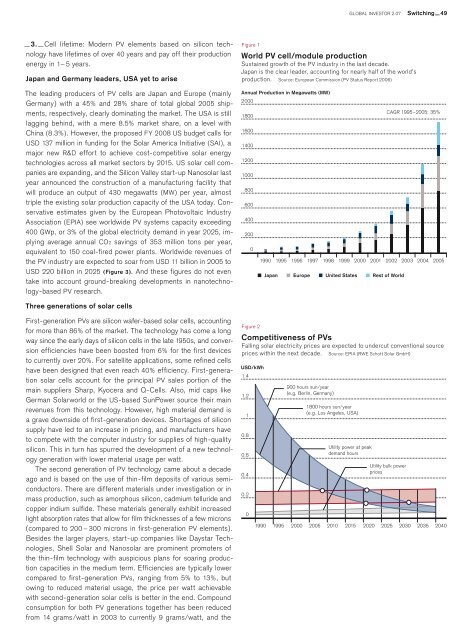You also want an ePaper? Increase the reach of your titles
YUMPU automatically turns print PDFs into web optimized ePapers that Google loves.
GLOBAL INVESTOR 2.07 Switching — 49<br />
—3.—Cell lifetime: Modern PV elements based on silicon technology<br />
have lifetimes of over 40 years and pay off their production<br />
energy in 1− 5 years.<br />
Japan and Germany leaders, USA yet to arise<br />
The leading producers of PV cells are Japan and Europe (mainly<br />
Germany) with a 45% and 28% share of total <strong>global</strong> 2005 shipments,<br />
respectively, clearly dominating the market. The USA is still<br />
lagging behind, with a mere 8.5% market share, on a level with<br />
China (8.3%). However, the proposed FY 2008 US budget calls for<br />
USD 137 million in funding for the Solar America Initiative (SAI), a<br />
major new R&D effort to achieve cost-competitive solar energy<br />
technologies across all market sectors by 2015. US solar cell companies<br />
are expanding, and the Silicon Valley start-up Nanosolar last<br />
year announced the construction of a manufacturing facility that<br />
will produce an output of 430 megawatts (MW) per year, almost<br />
triple the existing solar production capacity of the USA today. Conservative<br />
estimates given by the European Photovoltaic Industry<br />
Association (EPIA) see worldwide PV systems capacity exceeding<br />
400 GWp, or 3% of the <strong>global</strong> electricity demand in year 2025, implying<br />
average annual CO2 savings of 353 million tons per year,<br />
equivalent to 150 coal-fired power plants. Worldwide revenues of<br />
the PV industry are expected to soar from USD 11 billion in 2005 to<br />
USD 220 billion in 2025 (Figure 3). And these figures do not even<br />
take into account ground-breaking developments in nanotechnology-based<br />
PV research.<br />
Figure 1<br />
World PV cell/module production<br />
Sustained growth of the PV industry in the last decade.<br />
Japan is the clear leader, accounting for nearly half of the world’s<br />
production. Source: European Commission (PV Status Report 2006)<br />
Annual Production in Megawatts (MW)<br />
2000<br />
1800<br />
1600<br />
1400<br />
1200<br />
1000<br />
800<br />
600<br />
400<br />
200<br />
0<br />
1990 1995 1996 1997 1998 1999 2000 2001 2002 2003 2004 2005<br />
Japan Europe United States Rest of World<br />
CAGR 1995–2005: 35%<br />
Three generations of solar cells<br />
First-generation PVs are silicon wafer-based solar cells, accounting<br />
for more than 86% of the market. The technology has come a long<br />
way since the early days of silicon cells in the late 1950s, and conversion<br />
efficiencies have been boosted from 6% for the first devices<br />
to currently over 20%. For satellite applications, some refined cells<br />
have been designed that even reach 40% efficiency. First-generation<br />
solar cells account for the principal PV sales portion of the<br />
main suppliers Sharp, Kyocera and Q-Cells. Also, mid caps like<br />
German Solarworld or the US-based SunPower source their main<br />
revenues from this technology. However, high material demand is<br />
a grave downside of first-generation devices. Shortages of silicon<br />
supply have led to an increase in pricing, and manufacturers have<br />
to compete with the computer industry for supplies of high-quality<br />
silicon. This in turn has spurred the development of a new technology<br />
generation with lower material usage per watt.<br />
The second generation of PV technology came about a decade<br />
ago and is based on the use of thin-film deposits of various semiconductors.<br />
There are different materials under investigation or in<br />
mass production, such as amorphous silicon, cadmium telluride and<br />
copper indium sulfide. These materials generally exhibit increased<br />
light absorption rates that allow for film thicknesses of a few microns<br />
(compared to 200 − 300 microns in first-generation PV elements).<br />
Besides the larger players, start-up companies like Daystar Technologies,<br />
Shell Solar and Nanosolar are prominent promoters of<br />
the thin-film technology with auspicious plans for soaring production<br />
capacities in the medium term. Efficiencies are typically lower<br />
compared to first-generation PVs, ranging from 5% to 13%, but<br />
owing to reduced material usage, the price per watt achievable<br />
with second-generation solar cells is better in the end. Compound<br />
consumption for both PV generations together has been reduced<br />
from 14 grams/watt in 2003 to currently 9 grams/watt, and the<br />
Figure 2<br />
Competitiveness of PVs<br />
Falling solar electricity prices are expected to undercut conventional source<br />
prices within the next decade. Source: EPIA (RWE Schott Solar GmbH)<br />
USD/kWh<br />
1.4<br />
1.2<br />
1<br />
0.8<br />
0.6<br />
0.4<br />
0.2<br />
0<br />
900 hours sun/year<br />
(e.g. Berlin, Germany)<br />
1800 hours sun/year<br />
(e.g. Los Angeles, USA)<br />
Utility power at peak<br />
demand hours<br />
Utility bulk power<br />
prices<br />
1990 1995 2000 2005 2010 2015 2020 2025 2030 2035<br />
2040

















